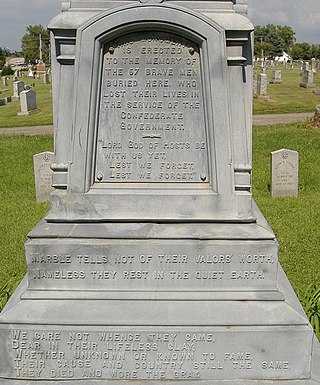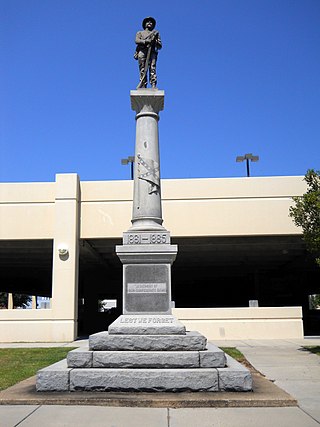
Hollywood Forever Cemetery is a full-service cemetery, funeral home, crematory, and cultural events center which regularly hosts community events such as live music and summer movie screenings. It is one of the oldest cemeteries in Los Angeles, California and is located at 6000 Santa Monica Boulevard in the Los Angeles neighborhood of Hollywood. It was founded in 1899 as Hollywood Cemetery, and, from 1939, was known as Hollywood Memorial Park until 1998 when it was given its current name. The studios of Paramount Pictures are located at the south end of the same block, on 40 acres (16 ha) that were once part of the cemetery which held no interments.

"Recessional" is a poem by Rudyard Kipling. It was composed for the Diamond Jubilee of Queen Victoria, in 1897.

The Confederate Monument of Bardstown, in Bardstown, Kentucky was erected in 1903 in the Bardstown St. Joseph's Cemetery to honor the sacrifice of 67 Confederate States Army soldiers, who died during the American Civil War. Some 17 of the soldiers are still unknown.

The Statue of Lenin is a 16 ft (5 m) bronze statue of Russian communist revolutionary Vladimir Lenin in the Fremont neighborhood of Seattle, Washington, United States. It was created by Bulgarian-born Slovak sculptor Emil Venkov and initially put on display in the Czechoslovak Socialist Republic in 1988, the year before the Velvet Revolution. After the dissolution of the Soviet Union, a wave of de-Leninization brought about the fall of many monuments in the former Soviet sphere. In 1993, the statue was bought by an American who had found it lying in a scrapyard. He brought it home with him to Washington State but died before he could carry out his plans to formally display it.
Confederate monuments and memorials in the United States include public displays and symbols of the Confederate States of America (CSA), Confederate leaders, or Confederate soldiers of the American Civil War. Many monuments and memorials have been or will be removed under great controversy. Part of the commemoration of the American Civil War, these symbols include monuments and statues, flags, holidays and other observances, and the names of schools, roads, parks, bridges, buildings, counties, cities, lakes, dams, military bases, and other public structures. In a December 2018 special report, Smithsonian Magazine stated, "over the past ten years, taxpayers have directed at least $40 million to Confederate monuments—statues, homes, parks, museums, libraries, and cemeteries—and to Confederate heritage organizations."

The Memorial to Company A, Capitol Guards was an American Civil War memorial in MacArthur Park, Little Rock, Arkansas. It stood just northeast of the former Tower Building of the Little Rock Arsenal, at a junction of two of the park's internal roadways. It consisted of a bronze sculpture depicting a Confederate Army soldier in a defensive stance, holding a rifle pointed forward. The statue was 8 feet (2.4 m) in height, and was mounted in a granite column 16 feet (4.9 m) tall. The memorial was sometimes known as "Lest we forget", a line that appeared near the top of the inscription on the base. The statue was created by sculptor Rudolph Schwarz, and was installed in 1911; it was paid for by the local chapter of the Sons of Confederate Veterans, and memorializes the unit that seized the arsenal at the outset of the war.

The Confederate Soldiers and Sailors Monument was a monument in Baltimore, Maryland, installed in 1903 and removed in 2017.

The Confederate Soldiers and Sailors Monument was a large granite monument that sat at the south entrance of Garfield Park in Indianapolis for nearly a century, before being removed in 2020. It commemorated the Confederate prisoners of war that died at Camp Morton. At 35 feet (11 m) tall and located in the city's oldest public park, it had been the most prominent of the very few Confederate memorials in the Union state of Indiana. It was dismantled and removed by the city of Indianapolis in June 2020 after a yearslong debate, part of a national wave of removal of Confederate memorials during the Black Lives Matter movement.

More than 160 monuments and memorials to the Confederate States of America and associated figures have been removed from public spaces in the United States, all but five since 2015. Some have been removed by state and local governments; others have been torn down by protestors.

Jefferson Davis Park is a private park located outside Ridgefield, Washington, in the southwestern portion of the state. The granite markers of the unofficial Jefferson Davis Memorial Highway are at the center of the park surrounded by Confederate flags. Operated by the Pacific Northwest chapter of the Sons of Confederate Veterans, the park commemorates Jefferson Davis, the pro-slavery President of the Confederate States of America.

"Their name liveth for evermore" is a phrase from the Jewish book of Ecclesiasticus or Sirach, chapter 44, verse 14, widely inscribed on war memorials since the First World War.

Known unto God is a phrase used on the gravestones of unknown soldiers in Commonwealth War Graves Commission (CWGC) cemeteries. The phrase was selected by British poet Rudyard Kipling who worked for what was then the Imperial War Graves Commission during the First World War. The origin of the phrase is unknown but it has been linked to sections of the King James Bible. The phrase was re-used for those killed during the Second World War and appears on more than 212,000 gravestones across the world. In 2013 there was controversy when it was proposed that the phrase be removed from the Tomb of the Unknown Soldier at the Australian War Memorial.

The United Confederate Veterans Memorial was a Confederate monument in Seattle's privately owned Lake View Cemetery, in the U.S. state of Washington. The memorial was erected by the United Daughters of the Confederacy in 1926. It was constructed of quartz monzonite from Stone Mountain, the Georgia landmark and birthplace of the modern Ku Klux Klan.

Fame, also called Gloria Victis, is a Confederate monument in Salisbury, North Carolina. Cast in Brussels, in 1891, Fame is one of two nearly-identical sculptures by Frederick Ruckstull. The monument was removed from public display in Salisbury on July 6, 2020.

The Confederate Monument in Gulfport, Mississippi is a monument dedicated to Confederate soldiers who died in the American Civil War. The statue was dedicated in 1911 and stands on the grounds of the Harrison County Courthouse.

Confederate Defenders of Charleston is a monument in Charleston, South Carolina, United States. The monument honors Confederate soldiers from Charleston, most notably those who served at Fort Sumter during the American Civil War. Built with funds provided by a local philanthropist, the monument was designed by Hermon Atkins MacNeil and was dedicated in White Point Garden in 1932. The monument, standing 17 feet (5.2 m) tall, features two bronze statues of a sword and shield-bearing defender standing in front of a symbolic representation of the city of Charleston. In recent years, the monument has been the subject of vandalism and calls for removal as part of a larger series of removal of Confederate monuments and memorials in the United States.















